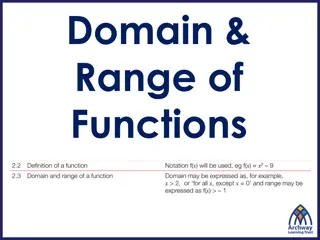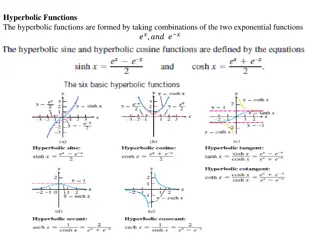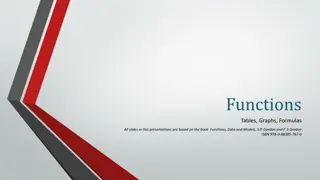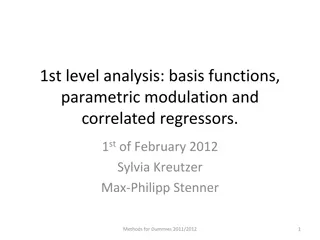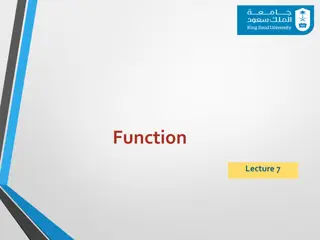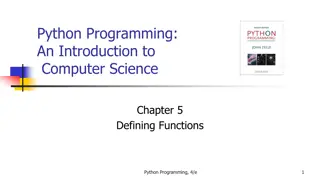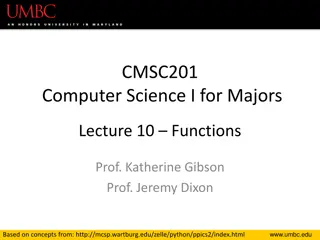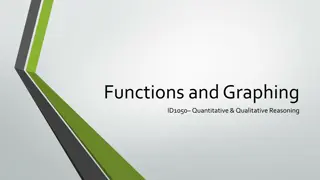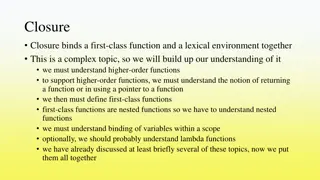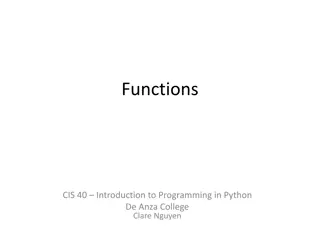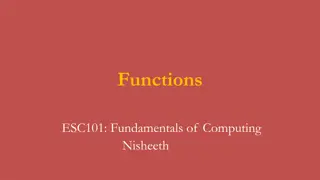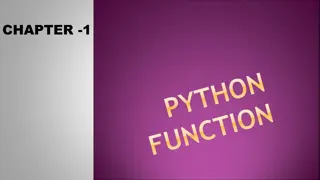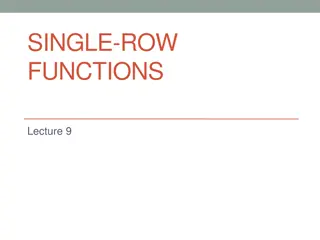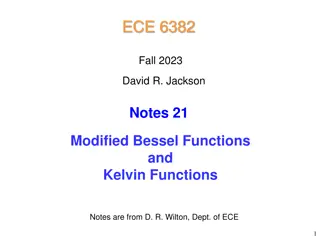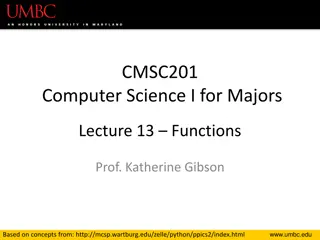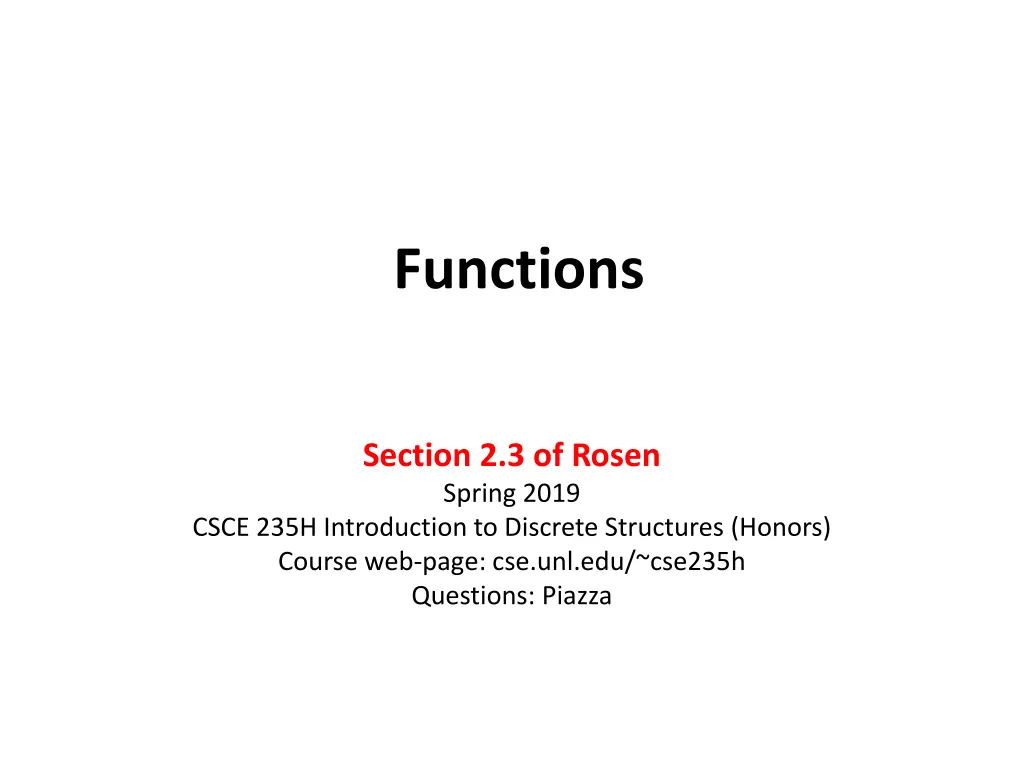
Understanding Functions in Discrete Structures
Explore the fundamental concepts of functions in discrete structures, including definitions, terminology, properties, and examples. Learn about domains, co-domains, images, preimages, ranges, and different types of functions such as one-to-one and onto functions.
Download Presentation

Please find below an Image/Link to download the presentation.
The content on the website is provided AS IS for your information and personal use only. It may not be sold, licensed, or shared on other websites without obtaining consent from the author. If you encounter any issues during the download, it is possible that the publisher has removed the file from their server.
You are allowed to download the files provided on this website for personal or commercial use, subject to the condition that they are used lawfully. All files are the property of their respective owners.
The content on the website is provided AS IS for your information and personal use only. It may not be sold, licensed, or shared on other websites without obtaining consent from the author.
E N D
Presentation Transcript
Functions Section 2.3 of Rosen Spring 2019 CSCE 235H Introduction to Discrete Structures (Honors) Course web-page: cse.unl.edu/~cse235h Questions: Piazza
Outline Definitions & terminology function, domain, co-domain, image, preimage (antecedent), range, image of a set, strictly increasing, strictly decreasing, monotonic Properties One-to-one (injective) Onto (surjective) One-to-one correspondence (bijective) Exercices (5) Inverse functions (examples) Operators Composition, Equality Important functions identity, absolute value, floor, ceiling, factorial 2 CSCE 235 Functions
Introduction You have already encountered function f(x,y) = x+y f(x) = x f(x) = sin(x) Here we will study functions defined on discrete domains and ranges We may not always be able to write function in a neat way as above 3 CSCE 235 Functions
Definition: Function Definition: A function f from a set A to a set B is an assignment of exactly one element of B to each element of A. We write f(a)=b if b is the unique element of B assigned by the function f to the element a A. Notation: f: A B which can be read as f maps A to B Note the subtlety Each and every element of A has a single mapping Each element of B may be mapped to by several elements in A or not at all 4 CSCE 235 Functions
Terminology Let f: A B and f(a)=b. Then we use the following terminology: A is the domain of f, denoted dom(f) B is the co-domain of f b is the image of a a is the preimage (antecedent) of b The range of f is the set of all images of elements of A, denoted rng(f) 5 CSCE 235 Functions
Function: Visualization Range Preimage Image, f(a)=b f a b B A Domain Co-Domain A function, f: A B 6 CSCE 235 Functions
More Definitions (1) Definition: Let f1 and f2 be two functions from a set A to R. Then f1+f2 and f1f2 are also function from A to R defined by: (f1+f2)(x) = f1(x) + f2(x) f1f2(x)= f1(x)f2(x) Example: Let f1(x)=x4+2x2+1 and f2(x)=2-x2 (f1+f2)(x) = x4+2x2+1+2-x2 = x4+x2+3 f1f2(x) = (x4+2x2+1)(2-x2)= -x6+3x2+2 7 CSCE 235 Functions
More Definitions (2) Definition: Let f: A B and S A. The image of the set S is the subset of B that consists of all the images of the elements of S. We denote the image of S by f(S), so that f(S)={ f(s) | s S } Note there that the image of S is a set and not an element. 8 CSCE 235 Functions
Image of a set: Example Let: A = {a1,a2,a3,a4,a5} B = {b1,b2,b3,b4,b5} f={(a1,b2), (a2,b3), (a3,b3), (a4,b1), (a5,b4)} S={a1,a3} Draw a diagram for f What is the: Domain, co-domain, range of f? Image of S, f(S)? 9 CSCE 235 Functions
More Definitions (3) Definition: A function f whose domain and codomain are subsets of the set of real numbers (R) is called strictly increasing if f(x)<f(y) whenever x<y and x and y are in the domain of f. strictly decreasing if f(x)>f(y) whenever x<y and x and y are in the domain of f. A function that is increasing or decreasing is said to be monotonic 10 CSCE 235 Functions
Outline Definitions & terminology Properties One-to-one (injective) Onto (surjective) One-to-one correspondence (bijective) Exercices (5) Inverse functions (examples) Operators Important functions 11 CSCE 235 Functions
Definition: Injection Definition: A function f is said to be one-to-one or injective (or an injection) if x and y in in the domain of f, f(x)=f(y) x=y Intuitively, an injection simply means that each element in the range has at most one preimage (antecedent) It is useful to think of the contrapositive of this definition x y f(x) f(y) 12 CSCE 235 Functions
Definition: Surjection Definition: A function f: A B is called onto or surjective (or an surjection) if b B, a A with f(a)=b Intuitively, a surjection means that every element in the codomain is mapped into (i.e., it is an image, has an antecedent) Thus, the range is the same as the codomain 13 CSCE 235 Functions
Definition: Bijection Definition: A function f is a one-to-one correspondence (or a bijection), if it is both one-to-one (injective) and onto (surjective) One-to-one correspondences are important because they endow a function with an inverse. They also allow us to have a concept cardinality for infinite sets Let s look at a few examples to develop a feel for these definitions 14 CSCE 235 Functions
Functions: Example 1 A B a1 a2 a3 a4 b1 b2 b3 b4 Is this a function? Why? No, because each of a1, a2 has two images 15 CSCE 235 Functions
Functions: Example 2 A B a1 a2 a3 a4 b1 b2 b3 b4 Is this a function One-to-one (injective)? Why? Onto (surjective)? Why? No, b1 has 2 preimages No, b4 has no preimage 16 CSCE 235 Functions
Functions: Example 3 A B a1 a2 a3 b1 b2 b3 b4 Is this a function One-to-one (injective)? Why? Onto (surjective)? Why? Yes, no bi has 2 preimages No, b4 has no preimage 17 CSCE 235 Functions
Functions: Example 4 A B a1 a2 a3 a4 b1 b2 b3 Is this a function One-to-one (injective)? Why? Onto (surjective)? Why? No, b3 has 2 preimages Yes, every bi has a preimage 18 CSCE 235 Functions
Functions: Example 5 A B a1 a2 a3 a4 b1 b2 b3 b4 Is this a function One-to-one (injective)? Onto (surjective)? Thus, it is a bijection or a one-to-one correspondence 19 CSCE 235 Functions
Exercice 1 Let f:Z Z be defined by f(x)=2x-3 What is the domain, codomain, range of f? Is f one-to-one (injective)? Is f onto (surjective)? Clearly, dom(f)=Z. To see what the range is, note that: b rng(f) b=2a-3, with a Z b=2(a-2)+1 b is odd 20 CSCE 235 Functions
Exercise 1 (contd) Thus, the range is the set of all odd integers Since the range and the codomain are different (i.e., rng(f) Z), we can conclude that f is not onto (surjective) However, f is one-to-one injective. Using simple algebra, we have: f(x1) = f(x2) 2x1-3 = 2x2-3 x1= x2 QED 21 CSCE 235 Functions
Exercise 2 Let f be as before f(x)=2x-3 but now we define f:N N What is the domain and range of f? Is f onto (surjective)? Is f one-to-one (injective)? By changing the domain and codomain of f, f is not even a function anymore. Indeed, f(1)=2 1-3=-1 N 22 CSCE 235 Functions
Exercice 3 Let f:Z Z be defined by f(x) = x2 - 5x + 5 Is this function One-to-one? Onto? 23 CSCE 235 Functions
Exercice 3: Answer It is not one-to-one (injective) f(x1)=f(x2) x12-5x1+5=x22 - 5x2+5 x12 - 5x1 = x22 - 5x2 x12 - x22 = 5x1 - 5x2 (x1 - x2)(x1 + x2) = 5(x1 - x2) (x1 + x2) = 5 Many x1,x2 Z satisfy this equality. There are thus an infinite number of solutions. In particular, f(2)=f(3)=-1 It is also not onto (surjective). The function is a parabola with a global minimum at (5/2,-5/4). Therefore, the function fails to map to any integer less than -1 What would happen if we changed the domain/codomain? 24 CSCE 235 Functions
Exercice 4 Let f:Z Z be defined by f(x) = 2x2 + 7x Is this function One-to-one (injective)? Onto (surjective)? Again, this is a parabola, it cannot be onto (where is the global minimum?) 25 CSCE 235 Functions
Exercice 4: Answer f(x) is one-to-one! Indeed: f(x1)=f(x2) 2x12+7x1=2x22 + 7x2 2x12 - 2x22 = 7x2 - 7x1 2(x1 - x2)(x1 + x2) = 7(x2 - x1) 2(x1 + x2) = -7 (x1 + x2) = -7 (x1 + x2) = -7/2 But -7/2 Z. Therefore it must be the case that x1 = x2. It follows that f is a one-to-one function. QED f(x) is not surjective because f(x)=1 does not exist 2x2 +7x=1 x(2x +7)=1 the product of two integers is 1 if both integers are 1 or -1 x=1 (2x+7)=1 9 =1, impossible x=-1 -1(-2+7)=1 -5=1, impossible 26 CSCE 235 Functions
Exercise 5 Let f:Z Z be defined by f(x) = 3x3 x Is this function One-to-one (injective)? Onto (surjective)? 27 CSCE 235 Functions
Exercice 5: f is one-to-one To check if f is one-to-one, again we suppose that for x1,x2 Z we have f(x1)=f(x2) f(x1)=f(x2) 3x13-x1=3x23-x2 3x13 - 3x23 = x1 - x2 3 (x1 - x2)(x12 +x1x2+x22)= (x1 - x2) (x12 +x1x2+x22)= 1/3 which is impossible because x1,x2 Z thus, f is one-to-one 28 CSCE 235 Functions
Exercice 5: f is not onto Consider the counter example f(a)=1 If this were true, we would have 3a3 a=1 a(3a2 1)=1 where a and (3a2 1) Z The only time we can have the product of two integers equal to 1 is when they are both equal to 1 or -1 Neither 1 nor -1 satisfy the above equality Thus, we have identified 1 Z that does not have an antecedent and f is not onto (surjective) 29 CSCE 235 Functions
Outline Definitions & terminology function, domain, co-domain, image, preimage (antecedent), range, image of a set, strictly increasing, strictly decreasing, monotonic Properties One-to-one (injective), onto (surjective), one-to-one correspondence (bijective) Exercices (5) Inverse functions (examples) Operators Composition, Equality Important functions identity, absolute value, floor, ceiling, factorial 30 CSCE 235 Functions
Inverse Functions (1) Definition: Let f:A B be a bijection. The inverse function of f is the function that assigns to an element b B the unique element a A such that f(a)=b The inverse function is denote f-1. When f is a bijection, its inverse exists and f(a)=b f-1(b)=a 31 CSCE 235 Functions
Inverse Functions (2) Note that by definition, a function can have an inverse if and only if it is a bijection. Thus, we say that a bijection is invertible Why must a function be bijective to have an inverse? Consider the case where f is not one-to-one (not injective). This means that some element b B has more than one antecedent in A, say a1 and a2. How can we define an inverse? Does f-1(b)=a1 or a2? Consider the case where f is not onto (not surjective). This means that there is some element b B that does not have any preimage a A. What is then f-1(b)? 32 CSCE 235 Functions
Inverse Functions: Representation f(a) a b f -1(b) B A Domain Co-Domain A function and its inverse 33 CSCE 235 Functions
Inverse Functions: Example 1 Let f:R R be defined by f(x) = 2x 3 What is f-1? 1. We must verify that f is invertible, that is, is a bijection. We prove that is one-to-one (injective) and onto (surjective). It is. 2. To find the inverse, we use the substitution Let f-1(y)=x And y=2x-3, which we solve for x. Clearly, x= (y+3)/2 So, f-1(y)= (y+3)/2 34 CSCE 235 Functions
Inverse Functions: Example 2 Let f(x)=x2. What is f-1? No domain/codomain has been specified. Say f:R R Is f a bijection? Does its inverse exist? Answer: No Say we specify that f: A B where A={x R |x 0} and B={y R | y 0} Is f a bijection? Does its inverse exist? Answer: Yes, the function becomes a bijection and thus, has an inverse 35 CSCE 235 Functions
Inverse Functions: Example 2 (cont) To find the inverse, we let f-1(y)=x y=x2, which we solve for x Solving for x, we get x= y, but which one is it? Since dom(f) is all nonpositive and rng(f) is nonnegative, thus x must be nonpositive and f-1(y)= - y From this, we see that the domains/codomains are just as important to a function as the definition of the function itself 36 CSCE 235 Functions
Inverse Functions: Example 3 Let f(x)=2x What should the domain/codomain be for this function to be a bijection? What is the inverse? The function should be f:R R+ Let f-1(y)=x and y=2x, solving for x we get x=log2(y). Thus, f-1(y)=log2(y) What happens when we include 0 in the codomain? What happens when restrict either sets to Z? 37 CSCE 235 Functions
Function Composition (1) The value of functions can be used as the input to other functions Definition: Let g:A B and f:B C. The composition of the functions f and g is (f g) (x)=f(g(x)) f g is read as f circle g , or f composed with g , f following g , or just f of g In LaTeX: $\circ$ 38 CSCE 235 Functions
Function Composition (2) Because (f g)(x)=f(g(x)), the composition f g cannot be defined unless the range of g is a subset of the domain of f f g is defined rng(g) dom(f) The order in which you apply a function matters: you go from the inner most to the outer most It follows that f g is in general not the same as g f 39 CSCE 235 Functions
Composition: Graphical Representation (f g)(a) rng(g) f(g(a)) g(a) a f(g(a)) g(a) g(a) domain(g) co- domain(g) domain(f) The composition of two functions 40 CSCE 235 Functions
Composition: Graphical Representation (f g)(a) f(g(a)) g(a) a g(a) f(g(a)) C B A The composition of two functions 41 CSCE 235 Functions
Composition: Example 1 Let f, g be two functions on R R defined by f(x) = 2x 3 g(x) = x2 + 1 What are f g and g f? We note that f is bijective, thus dom(f)=rng(f)= codomain(f)= R For g, dom(g)= R but rng(g)={x R | x 1} R+ Since rng(g)={x R | x 1} R+ dom(f) =R, f g is defined Since rng(f)= R dom(g) =R , g f is defined 42 CSCE 235 Functions
Composition: Example 1 (cont) Given f(x) = 2x 3 and g(x) = x2 + 1 (f g)(x) = f(g(x)) = f(x2+1) = 2(x2+1)-3 = 2x2 - 1 (g f)(x) = g(f(x)) = g(2x-3) = (2x-3)2 +1 = 4x2 - 12x + 10 43 CSCE 235 Functions
Function Equality Although it is intuitive, we formally define what it means for two functions to be equal Lemma: Two functions f and g are equal if and only dom(f) = dom(g) a dom(f) (f(a) = g(a)) 44 CSCE 235 Functions
Associativity The composition of function is not commutative (f g g f), it is associative Lemma: The composition of functions is an associative operation, that is (f g) h = f (g h) 45 CSCE 235 Functions
Outline Definitions & terminology function, domain, co-domain, image, preimage (antecedent), range, image of a set, strictly increasing, strictly decreasing, monotonic Properties One-to-one (injective), onto (surjective), one-to-one correspondence (bijective) Exercices (5) Inverse functions (examples) Operators Composition, Equality Important functions identity, absolute value, floor, ceiling, factorial 46 CSCE 235 Functions
Important Functions: Identity Definition: The identity function on a set A is the function : A A $\iota$ defined by (a)=a for all a A. One can view the identity function as a composition of a function and its inverse: (a) = (f f-1)(a) = (f-1 f)(a) Moreover, the composition of any function f with the identity function is itself f: (f )(a) = ( f)(a) = f(a) 47 CSCE 235 Functions
Inverses and Identity The identity function, along with the composition operation, gives us another characterization of inverses when a function has an inverse Theorem: The functions f: A B and g: B A are inverses if and only if (g f) = A and (f g) = B where the A and B are the identity functions on sets A and B. That is, a A, b B ( (g(f(a)) = a) (f(g(b)) = b) ) 48 CSCE 235 Functions
Important Functions: Absolute Value Definition: The absolute value function, denoted x , f f:R {y R | y 0}. Its value is defined by x if x 0 x = -x if x 0 49 CSCE 235 Functions
Important Functions: Floor & Ceiling Definitions: The floor function, denoted x , is a function R Z. Its values is the largest integer that is less than or equal to x The ceiling function, denoted x , is a function R Z. Its values is the smallest integer that is greater than or equal to x In LaTex: $\lceil$, $\rceil$, $\rfloor$, $\lfloor$ 50 CSCE 235 Functions


